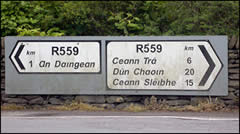Road Signs in Europe
There are hundreds of road signs blocking your view on European roads and—more importantly—telling you how to get where you're going. Luckily most of them are pretty intuitive.
 In addition to that whole driving on the left bit, Ireland throws an additional curve-ball at Yankee drivers with this: far too many roundabouts instead of intersections--and road signs in Gaelic.
In addition to that whole driving on the left bit, Ireland throws an additional curve-ball at Yankee drivers with this: far too many roundabouts instead of intersections--and road signs in Gaelic.
In another stroke of good fortune, most of Europe has become pretty standardized when it comes to signage, so you should have little trouble driving from one country to the next and figuring out what the speed limit is and where you can't park.
Below is a chart showing all the most important common signs you'll see in Europe. I'm leaving out a few of the ones that will be patently obvious once you are in Europe—like the red octagon that says "STOP" on it in white. That one's universal.
  |
Speed limit/End speed limit. (In this case, 60kph). In most parts of Europe, this is considered more of a suggestion than a guideline. |
  |
Minimum speed/End minimum speed zone. Frankly, I've no idea why they bother posting these, since Europeans seem to observe the actual speed limit sign as meaning "this is as slow as you should be going." |
 |
Dead end / no outlet. |
 |
Do not enter. |
  |
Highway begins/Highway ends. Note that major highways (autobahn / autoroute / autostrada—what we would call an interstate) are usually tagged with green signs, while smaller highways are in blue. That means if you see two signs, one blue pointing right and one green pointing left, both reading "ROMA" you would turn left to take the autostrada to Rome, or right to follow a lesser highway to the Eternal City. As in America, the blue highways are slower, but usually more interesting. |
 |
Keep to the right. (Also available in "Keep to the left" flavor.) This often appears in divided roadway situations or at roundabouts. |
 |
No parking (on whichever side of the street the sign is hanging/posted). |
 |
No stopping. |
 |
No passing. They mean it. |
 |
Parking. Usually, this means paid parking, so look for a common meter down at the end of the block, pop in a few coins, and leave the receipt it spits out on your dashboard. |
 |
You have the right of way over oncoming traffic (a necessary sign on a continent where roads often narrow to significantly less than two full lanes...or, come to think of it, even one full lane). |
 |
You must yield to oncoming traffic. |
 |
Yield. This is a good direction to follow at all times, regardless of signage, since the local drivers have a much better idea of what they're doing and where they're going than you do. |
One Way. Note that, even though in Italy this seems to mean, "It's OK simply to point your car the right way but then put it in reverse and back down the street," this is not a driving technique to be attempted by visitors. |
|
 |
Center of town. It may be called Zentrum, centre, or centro, but just follow the bulls eye and you'll find your way to the heart of the city every time. |
Related Articles |
Related Partners |
This article was by Reid Bramblett and last updated in April 2011.
All information was accurate at the time.
Copyright © 1998–2013 by Reid Bramblett. Author: Reid Bramblett.
